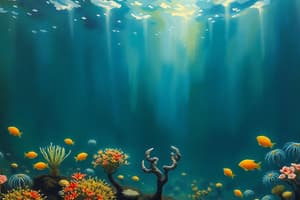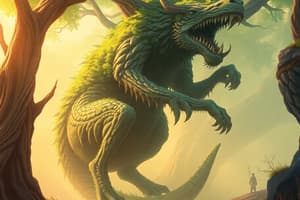Podcast
Questions and Answers
What symbol is used to indicate a connection or relationship?
What symbol is used to indicate a connection or relationship?
- =
- -
- & (correct)
- ②
What does the arrow '→' suggest?
What does the arrow '→' suggest?
- Subtraction
- Addition
- Direction (correct)
- Equality
What is the purpose of the '-' symbol?
What is the purpose of the '-' symbol?
- To separate items (correct)
- To indicate subtraction
- To represent a connection
- To indicate multiplication
What does the '=' symbol represent?
What does the '=' symbol represent?
What is the theme of the given content?
What is the theme of the given content?
What is the term 'ewaste' short for?
What is the term 'ewaste' short for?
What is the concentration of HCB in the Common Tern?
What is the concentration of HCB in the Common Tern?
Which species has the highest concentration of HCB?
Which species has the highest concentration of HCB?
What is the source of the information about the HCB concentrations?
What is the source of the information about the HCB concentrations?
Which species is not mentioned in the content?
Which species is not mentioned in the content?
What is a common use of PCBs?
What is a common use of PCBs?
What is the abbreviation of the chemical mentioned in the content?
What is the abbreviation of the chemical mentioned in the content?
What is a source of unintentionally produced dioxins and furans?
What is a source of unintentionally produced dioxins and furans?
Which species is mentioned in the content with the concentration of HCB as 500 ug/kg?
Which species is mentioned in the content with the concentration of HCB as 500 ug/kg?
What is the effect of the chemical mentioned in the content on living organisms?
What is the effect of the chemical mentioned in the content on living organisms?
What is toxaphene used for?
What is toxaphene used for?
Which species has a concentration of HCB as 2253/1808 ug/kg?
Which species has a concentration of HCB as 2253/1808 ug/kg?
Where can PCBs be found as trace contaminants?
Where can PCBs be found as trace contaminants?
What type of pesticide was used primarily against soil insects and termites?
What type of pesticide was used primarily against soil insects and termites?
What is a common industrial process that unintentionally produces PCBs?
What is a common industrial process that unintentionally produces PCBs?
Which of the following pesticides was used to control malaria and typhus?
Which of the following pesticides was used to control malaria and typhus?
What is a use of PCBs in electrical systems?
What is a use of PCBs in electrical systems?
What type of pesticide was used for seed treatment and as an industrial chemical?
What type of pesticide was used for seed treatment and as an industrial chemical?
Which of the following pesticides was used to combat fire ants and termites?
Which of the following pesticides was used to combat fire ants and termites?
What type of pesticide was used on crops such as corn and cotton?
What type of pesticide was used on crops such as corn and cotton?
Which of the following pesticides was used to control termites and mealybugs?
Which of the following pesticides was used to control termites and mealybugs?
What type of pesticide was used on home lawn and garden pests?
What type of pesticide was used on home lawn and garden pests?
Which of the following pesticides was used to control termites and as a fire retardant?
Which of the following pesticides was used to control termites and as a fire retardant?
Flashcards are hidden until you start studying
Study Notes
Persistent Organic Pollutants (POPs)
- POPs are a group of toxic substances that persist in the environment for a long time, causing harm to humans and wildlife.
Sources of POPs
- Aldrin and dieldrin: insecticides used on crops such as corn and cotton, and for termite control.
- Chlordane: insecticide used on crops, home lawn and garden pests, and to control termites.
- DDT: insecticide used on agricultural crops, primarily cotton, and to combat diseases such as malaria and typhus.
- Endrin: insecticide used to combat fire ants, termites, and mealybugs, and as a fire retardant in plastics, rubber, and electrical products.
- Heptachlor: insecticide used primarily against soil insects and termites, and to combat malaria.
- Hexachlorobenzene: fungicide used for seed treatment, and as an industrial chemical used to make fireworks, ammunition, synthetic rubber.
- PCBs: used for a variety of industrial processes, including in electrical transformers and capacitors, as heat exchange fluids, as paint additives, in carbonless copy paper, and in plastics.
- Toxaphene: insecticide used to control pests on crops and to kill unwanted fish in lakes.
- Dioxins and furans: unintentionally produced during most forms of combustion, including burning of municipal and medical wastes, backyard burning of trash, and industrial processes.
Effects of POPs
- Bioaccumulation: POPs can accumulate in the fatty tissues of living organisms, including humans, and can be passed on to offspring.
- Biomagnification: POPs can increase in concentration as they move up the food chain, leading to higher levels of toxicity in predators.
Examples of POPs in Wildlife
- Common tern: HCB levels of 3 ug/kg.
- Cape petrel: HCB levels of 2253/1808 ug/kg.
- Adelie penguin: HCB levels of 500 ug/kg.
Studies on POPs
- Van den Brink (1997): study on the effects of POPs on wildlife.
Studying That Suits You
Use AI to generate personalized quizzes and flashcards to suit your learning preferences.




